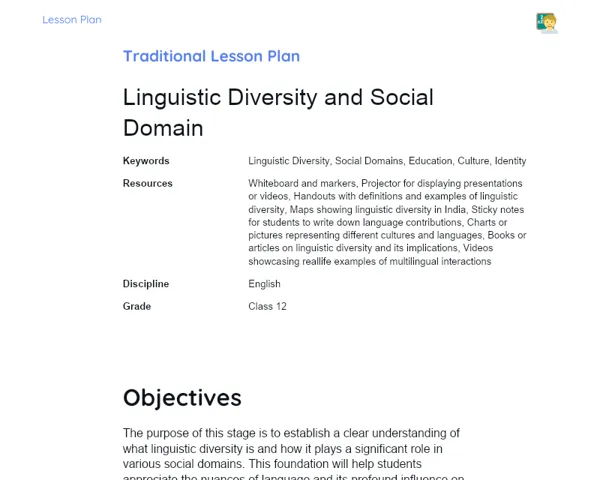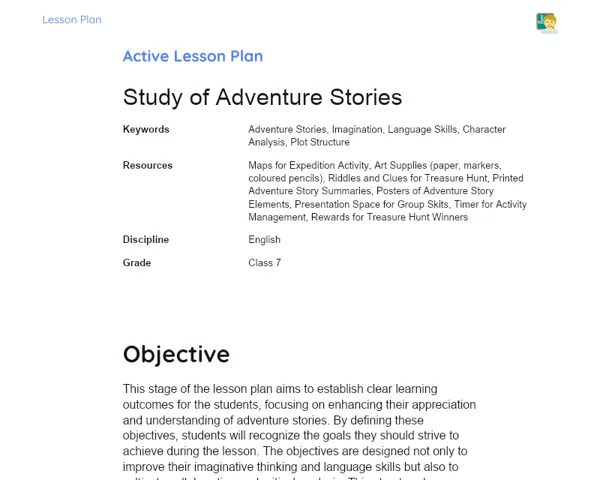Lesson Plan | Socioemotional Learning | Verbs: Future with Going to and Will
| Keywords | Future Tenses, Going to, Will, English Grammar, Socio-Emotional Learning, Self-Awareness, Self-Control, Responsible Decision-Making, Social Skills, Social Awareness, RULER, Guided Meditation, Constructive Feedback, Emotional Expression, Emotional Regulation |
| Resources | Whiteboard and markers, Projector or screen for presentations, Paper sheets, Pens and pencils, Cards for writing goals, Digital resources (for guided meditation, if available), Printed copies of grammar exercises |
| Codes | - |
| Grade | 12th grade |
| Discipline | English |
Objective
Duration: (10 - 15 minutes)
This stage is designed to introduce students to the concept of future tenses in English, focusing on ‘going to’ and ‘will’. The initial exposure is important to build a solid foundation, ensuring that students appreciate the significance and proper context of each form. Moreover, this phase prepares them to recognise and use these grammatical structures effectively in real-life situations.
Objective Utama
1. Identify and distinguish between the future tense forms 'going to' and 'will' in English.
2. Use 'going to' and 'will' accurately in contextually appropriate sentences.
Introduction
Duration: (10 - 15 minutes)
Emotional Warmup Activity
🌟 Connecting with a Calm Mind 🌟
The selected warm-up activity is a Guided Meditation session. This method is intended to help students relax, focus, and be present before diving into the lesson.
1. Prepare the Environment: Ask students to sit comfortably with their feet firmly on the floor and hands resting on their laps.
2. Posture: Request them to sit up straight yet relaxed, and gently close their eyes.
3. Breathing Exercise: Direct them to focus on their breathing. Instruct them to take a deep breath in through the nose, allow the air to fill their lungs, and then exhale slowly through the mouth.
4. Visualization: Encourage students to picture a peaceful and safe space, such as a quiet beach or a serene park. Urge them to engage their senses – notice the sounds, the aromas, and the pleasant temperature.
5. Body Check: Guide them through a body scan starting from the feet and moving upwards, relaxing any areas of tension as they progress.
6. Wrap-Up: After around 5 minutes, ask them to gradually bring their focus back by wiggling their fingers and toes, and then slowly open their eyes.
Content Contextualization
When studying future tenses like 'going to' and 'will' in English, it’s essential to understand that they serve to express plans, intentions, or predictions. For example, think of someone unsure about what the future holds: they might say 'I am going to study hard for the exams' to talk about a planned action, or 'I will help you with your studies' when making an on-the-spot promise. Grasping how language communicates our plans and feelings not only aids in mastering grammar but also helps in nurturing socio-emotional skills such as empathy and effective communication.
Development
Duration: (60 - 75 minutes)
Theory Guide
Duration: (20 - 25 minutes)
1. Introduction to Future Tenses: 'Going to' and 'Will'
2. Explain that in English there are two primary ways to express the future – using 'going to' and 'will'. Each is used according to the situational context.
3. Usage of 'Going to'
4. Definition: 'Going to' is used for plans and intentions that have been decided before the moment of speaking, and for predictions based on present evidence.
5. Example: 'I am going to visit my grandparents next weekend.' (Plan)
6. Example: 'Look at those dark clouds! It’s going to rain.' (Prediction)
7. Usage of 'Will'
8. Definition: 'Will' is used for spontaneous decisions, promises, offers, and predictions that do not rely on prior evidence.
9. Example: 'I will help you with your homework.' (Spontaneous decision)
10. Example: 'Don’t worry, I will call you when I get there.' (Promise)
11. Key Differences between 'Going to' and 'Will'
12. Context and Intention: 'Going to' is typically used when a plan is already in place, whereas 'will' is used for decisions made in the moment.
13. Observable Evidence: 'Going to' is often linked to observable indications in the present, unlike 'will'.
14. Practice and Examples
15. Propose exercises where students can practice choosing between 'going to' and 'will'. For instance, supply sentences with blanks and ask them to fill in the correct future form.
16. Example Exercise: 'She __________ (go) to the supermarket tomorrow.' (Answer: 'is going to go')
Activity with Socioemotional Feedback
Duration: (30 - 35 minutes)
🌟 Planning the Future with 'Going to' and 'Will' 🌟
In this activity, students will be tasked with writing a script about a day in their future, incorporating both 'going to' and 'will' to express actions and intentions. After writing, students will share their scripts in small groups, facilitating feedback and discussions that touch upon both linguistic and socio-emotional aspects.
1. Form Groups: Arrange students into groups of 3-4.
2. Script Writing: Each student should prepare a script for a future day, ensuring to use both 'going to' and 'will' appropriately.
3. Sharing Session: After the scripts are ready, have each student read out their story within the group.
4. Feedback with a Socio-Emotional Touch: Encourage peers to offer constructive, friendly feedback, pointing out the effective use of 'going to' and 'will', as well as any emotional expression in the narratives.
5. Class Presentation (Optional): Ask one or two groups to present their stories to the entire class.
Discussion and Group Feedback
During group discussions, guide students to use the RULER method for socio-emotional feedback:
Recognize: Ask them to identify and acknowledge the emotions expressed in their peers’ stories, such as excitement or nervousness about upcoming events.
Understand: Help students understand the reasons behind these emotions. For instance, if a student expresses anxiety about an exam, talk about how such feelings might affect their performance.
Name: Encourage them to precisely name the observed emotions, thus expanding their emotional vocabulary.
Express: Prompt students to share their own feelings respectfully in response to their peers’ experiences.
Regulate: Discuss practical strategies to control intense emotions, ensuring that everyone can reflect on and manage their emotional state.
Conclusion
Duration: (15 - 20 minutes)
Reflection and Emotional Regulation
Encourage students to write down a brief reflection on the challenges they encountered during the lesson – for example, understanding the subtle differences between 'going to' and 'will' and managing emotions during group interactions and feedback sessions. Alternatively, a group discussion can be held where they share their experiences of using the RULER method.
Objective: This part of the lesson aims to promote self-assessment and emotional control. Reflecting on their experiences helps students develop a better understanding of themselves, leading to improved self-awareness, social interactions, and decision-making skills.
Glimpse into the Future
To wrap up the lesson, ask students to set a few personal and academic objectives related to today's topic. These objectives might involve practising the correct usage of 'going to' and 'will' in their writing and conversations, as well as enhancing their skills in giving constructive feedback and expressing emotions appropriately. They can jot these goals in their notebooks and share them with a friend to build a support system.
Penetapan Objective:
1. Improve the ability to differentiate between 'going to' and 'will' in grammar exercises.
2. Use 'going to' and 'will' correctly in everyday written and spoken English.
3. Enhance skills in providing and accepting constructive feedback.
4. Express emotions suitably in academic settings.
5. Maintain a journal to reflect on the application of socio-emotional skills in daily life. Objective: This section is intended to strengthen students' autonomy and practical application of the lesson. Setting clear targets aids them in tracking progress and adjusting study strategies, thereby fostering continuous learning both academically and in terms of emotional intelligence.



